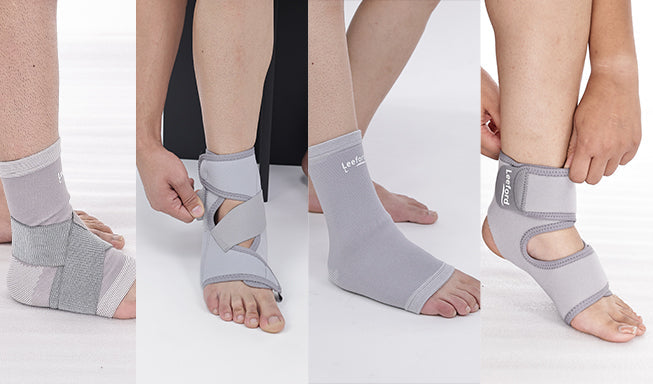You’ve probably twisted your ankle at some point, or maybe someone close to you has. Ouch, right? One minute you’re walking, jogging, or dancing, and the next, your ankle decides to rebel. That’s where ankle splints come into play. But honestly, if you’ve never used one before, it can be confusing. There are so many types. So, in this blog, let’s understand which ankle splint works for what, and maybe even which one could become your ankle’s healing partner.
Why Ankle Splints Are Important?
When you injure your ankle like a sprain or a minor fracture, the ligaments, tendons, and muscles around it can get overstretched or weak. An ankle splint supports the joint and keeps it stable.
Splints don’t just protect. They also:
- Reduce swelling by keeping things snug and in place.
- Protect ligaments and also prevent the injury from getting worse.
- Limit unwanted movements that generally cause pain or delays in your healing.
- Help prevent re-injury when you start walking or moving again.
Leeford Ortho Ankle Braces combine the comfort of soft braces with the support of rigid braces, perfect if you’re unsure which one to pick.
Types of Ankle Splints
Alright, now let’s get to the main part which is the different ankle splints out there. Let’s look at those:
Soft Ankle Braces
These are the ones you see most people wear after a minor sprain. They’re usually made of elastic, breathable fabric. Sometimes they have Velcro straps so that you can very easily adjust the tightness.
Who are they for?
-
Mild sprains or strains
-
Support during sports like tennis, basketball, or running
-
Daily wear if you want a little extra support
Pros & Cons of Soft Ankle Braces
|
Pros |
Cons |
|
Lightweight and comfortable |
Limited stability for severe injuries |
|
Can fit in most shoes |
Won’t protect much if you twist your ankle badly again |
|
Easy to put on and take off |
May need to be replaced more frequently if used daily |
Rigid Ankle Splints
Most splints are pretty rigid since they’re crafted with strong plastic or a metal-plastic mix. They don’t bend much, which is exactly what your ankle needs if it’s really hurt.
Who are they for?
-
Moderate to severe sprains
-
Post-surgery support
-
People prone to re-injury
Pros & Cons of Rigid Ankle Splints
|
Pros |
Cons |
|
Provides maximum stability |
Bulky, so shoes might not fit comfortably |
|
Keeps the ankle correctly to heal |
Less flexible, so not ideal for all-day wear |
|
Reduces the recurrence of further injury |
Can feel quite restrictive when you do any movement |
Lace-Up Ankle Braces
These are kind of a middle ground. They combine soft fabric with laces, which allows you to adjust the tightness exactly how you want it.
Who are they for?
- Mild to moderate sprains
- People who want more control over support
-
Athletes returning to sports after injury
Pros & Cons of Lace-Up Ankle Braces
|
Pros |
Cons |
|
Adjustable support |
May not provide enough rigidity if you have severe injuries |
|
Lightweight |
Laces can come undone if they are not tied properly |
|
Can fit inside many shoes quite easily |
You might need to re-adjust during long activity |
Air-Stirrup or Pneumatic Ankle Braces
They use air bladders to provide support. You can inflate them to give your ankle a snug fit.
Who are they for?
-
Moderate sprains
-
People who need adjustable compression
-
Situations where swelling is quite expected
Pros & Cons of Air-Stirrup or Pneumatic Ankle Braces
|
Pros |
Cons |
|
Adjustable support and compression |
More expensive than basic braces |
|
Can reduce swelling faster |
Can be tricky to fit correctly at first |
|
Often more comfortable than rigid braces |
May require regular checking of air levels |
Walking Boots or CAM (Controlled Ankle Motion) Boots
They’re big, plastic, and sometimes come with a little rocker bottom to make walking easier.
Who are they for?
-
Severe sprains
-
Minor fractures
-
Post-surgery recovery
Pros & Cons of Walking Boots or CAM (Controlled Ankle Motion) Boots
|
Pros |
Cons |
|
Maximum protection and stability |
Very bulky |
|
Can allow you to walk while healing |
Not stylish at all |
|
Often used under doctor supervision |
Can be heavy and cumbersome |
Choosing the Best Ankle Splint for a Sprain
Now for the million-dollar question which you might think about sometimes: Which ankle splint is best for a sprain?
It really depends on the severity:
-
Mild sprain: Soft brace or lace-up brace
-
Moderate sprain: Rigid splint, air-stirrup, or lace-up brace with extra support
- Severe sprain: CAM boot or rigid brace as recommended by a doctor
Follow this tip for effectiveness: If your ankle swells a lot or you can’t put weight on it, then you should always go for more support.
Can You Easily Wear Shoes Over an Ankle Splint?
Yes, but it depends on the type.
-
Soft braces and lace-up braces: Usually fit inside most shoes. Sneakers are ideal.
-
Rigid splints: Might fit in larger shoes, but often you’ll need a wider shoe.
- CAM boots: Forget regular shoes. You need a boot or sandal that fits over it quite easily.
So, always check your footwear before stepping out. Comfort is key; you don’t want to cause new pain by squishing your ankle.
Do Ankle Splints Help Prevent Re-Injury?
By limiting unwanted movements, ankle splints give your ligaments and tendons a chance to heal properly. They also remind you to move cautiously. These act as both a physical and mental safety net. For athletes or anyone prone to sprains, wearing a brace during high-risk activities can reduce the chance of rolling your ankle again. Of course, no splint is a cure, so combining it with strengthening exercises is always better.
Tips for Using Ankle Splints Effectively
Here are some very easily doable tips to get the most out of your ankle splint:
-
Follow doctor's advice: Especially for moderate to severe injuries.
-
Keep it snug but not tight: You want support, not circulation problems.
-
Wear it as recommended: Some splints are for all-day use; others only during activity.
-
Check for swelling: If your foot becomes numb or changes color, make sure to just loosen the brace immediately.
-
Combine with R.I.C.E: It means Rest, Ice, Compression, and Elevation work wonders alongside your splint.
- Do gentle ankle exercises: Once healing starts, it’s important to regain flexibility and strength.
Final Thoughts
Injuring your ankle can be frustrating. But the right ankle splint can make a world of difference. It’s not just about protection; it’s about giving your ankle the chance to heal safely. If you are looking for the best option for your healing journey, Leeford Ortho Ankle Brace provides a perfect balance of support and comfort. Whether you’re dealing with a minor sprain or returning to sports after recovery, you can opt for it.
Remember, no one ankle is the same. Listen to your body, and choose the support that fits your needs. If unsure, reach out to your doctor or physiotherapist; they can really help by guiding you and save you time.
Your ankle deserves proper care, and with the right splint, you’ll be back on your feet literally sooner than you think.





